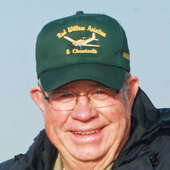- Lives touched across thousands of miles (4/9/24)
- Funerals and other happy times (4/2/24)
- Blizzards, tornadoes and Easter traditions (3/26/24)
- From making our bed to making democracy work (3/19/24)
- Biden's speech, a missed opportunity and theater triumph (3/12/24)
- From Plain Jane to high tech: Nostalgia vs. modern conveniences in automobiles (3/5/24)
- Taxes, inflation and support for veterans (2/27/24)
Opinion
Experiencing true living history
Saturday, May 5, 2007
Mea culpa as charged. Gloria Masoner pegged it right and I have no doubt that the in crowd at Sarge's is just like the characters we enjoyed when Cheers was on TV.
I'll take her word for it as I haven't been back since the proprietor chewed my tail for parking in his lot without his specific permission. Further Gloria illustrated the occasional problems that, I suspect, are exactly why the good people at the Senior Center are against the use of alcohol there.
Gloria did neglect to mention that the good people at Sarge's do wonderful things to help the disadvantaged in our community. They have unselfishly given funds that have made Christmas memorable for families and individuals truly in need. And hey I said I loved you all!
I had a great weekend last totally immersed in western history. The occasion was the biennial Fort Robinson History Conference at that State Park. The drive to Fort Rob across vibrantly greening rural western Nebraska was worth the time invested plus I savored one-on-one conversation with my wife during the trip.
The conference, our third, was a three-day affair titled "Four-Legged Soldiers." The mornings were spent in the Post Theatre listening to scholars present original research papers on such esoteric subjects as "The Best Arms for the Cavalry: The Great Debate," "'They Wore Diamonds' Pack Mules, Indispensable Logistical Support for the Army," and "Writing Nokota Horses into History," plus others.
Afternoons were spent touring actual nearby battlefields, and the variety of restored buildings at the fort, most of which date back to the time when it was an active outpost of the Frontier Army.
There is something magical about being in the actual location of the western heritage that we took for granted as we all grew up.
Ann and I were joined by my brother Tom and our sister Margaret and husband Dale Nielsen from Lexington. We were assigned sleeping quarters in what was a duplex built in 1875 to house Noncommissioned officers and their families.
It is located just across the parade ground from where Crazy Horse was stabbed and died during an escape attempt. That would be the original "Old Sarge's" quarters. By today's motel standards it was Spartan but we had heat, hot and cold water, a shower and a kitchen that we didn't use. There was a queen size bed, two sets of bunk beds and a common bathroom. I think we all decided that adult slumber parties aren't nearly as much fun due to powerful snoring and frequent nocturnal trips to the john. Privacy, nah!
In school we were taught that the Plains Indians attained their horses by capturing wild mustangs that had gotten away from the early Spanish explorers in the southeast United States.
Recent research has revealed that "everybody knows" fact to be inaccurate.
For starters shipping records show that of 600 horses shipped from Spain to the unexplored North America, only two were mares. It turns out that the Sioux actually got their horses by trade with other Indian tribes through Santa Fe so they were actually western bred of Spanish and other European bloodlines.
The horse completely changed the character of the Sioux but it was a revolution that only occupied about 150 years. When the US Army finally subdued the Sioux in the area surrounding Fort Robinson, one thing done was to take most of their horses from them. That occurred also about 150 years ago and so the Sioux have been reservation Indians for about as long a time as they were the horse culture people that we have been brought up to think of as our western Indians.
Recent research of wild mustang ponies found in North Dakota's Roosevelt National Park has proven that these horses, now named Nokota Horses, are the direct descendants of the horses that the Army took away from the Sioux.
Castle McLaughlin, a young woman, now working at the Peabody Museum, Harvard University, spoke of her field work, researching the archives, and doing DNA testing to prove the genetic lineage of this unique breed of Indian ponies. Also present were two stallions typical of the breed. I found them to be smaller than expected, true ponies.
One was a blue roan with light blue eyes and it took little imagination to see Sitting Bull himself sitting upon his back atop the typical soft Indian saddle.
A highlight of the conference was listening to a presentation by Ed Bieganski, father of longtime McCook hospital administrator Gary Bieganski. Ed had enlisted in the U.S. Army Quartermaster Corps in August 1938, and had actually been stationed at Fort Robinson when it was an active duty remount station. Talk about living history!

